The Nature of Change
Since 2012 Jeff Roehm has volunteered as a site steward for North Coast Land Conservancy, monitoring five NCLC properties in the Neawanna estuary in Seaside. His “Love Letter to a Tidal Marsh ,” about Wahanna Marsh, ran in this People+Plants+Wildlife blog last fall. Here he returns to the marsh and reports on how its very nature is changing, and why.
It’s a sunny day at the end of June, and I’m in the wetlands west of Wahanna Road in Seaside, looking north over Coho Creek. I’ve just finished visiting Salmonberry Knoll Habitat Reserve, and I’m about to cross this little creek into Wahanna Marsh Habitat Reserve. This is a very special place. I wonder what I’ll find today?
It was an interesting winter here. In my previous blog post, I just mentioned in passing that there was a new beaver dam on China Creek, which forms the north border of the property. You could see that the water table was up and the marsh was starting to look a little different. Since then the beavers have moved in big time, diverting much water flow to the south into the pond that lines the east side of the marsh. By the time the king tides hit in early January, the water level had gone up and it stayed up. It was basically high tide all of the time.
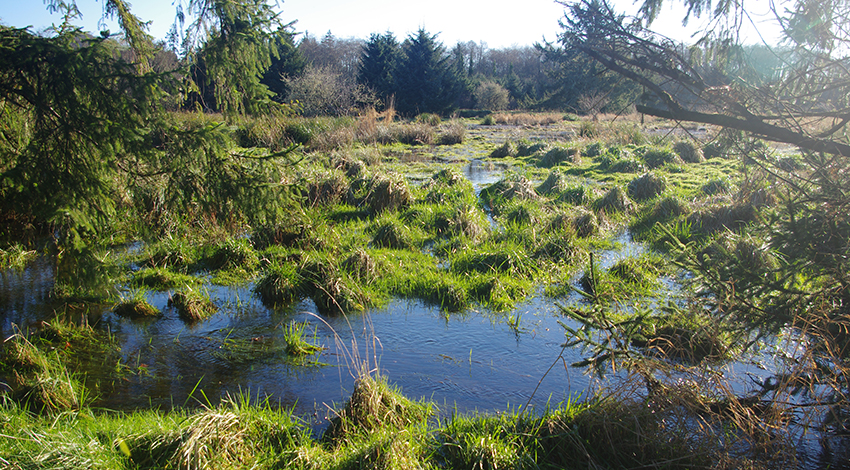
I was so interested in what was going on I began keeping a close watch all winter and into the spring. I even walked out here during one of those king tides, which is something I’d never had the courage to do before. I guess you just get used to things, and what once seemed impossible, or at the very least a bad idea, now you just did.
Then in the middle of May I just had to see what things looked like. In the first place, the native crabapples were leafing out along the North Coast, and I wanted to see how they were doing in this marsh’s new, wetter conditions. Friends of mine, NCLC volunteers, had been asking me to take them out to see the marsh ever since I’d made that blog post. I needed to see just what kind of a deal (or ordeal) that might be.
Nothing seemed very different at first. The water in the pond behind the dam closest to the road was actually down about two inches but was still moving out into the ponds to the south in more or less a trickle. The rest of the walk out into the spruce grove was very wet, even though there was actually less water in the marsh. There were obvious beaver trails everywhere, and they were well-used, with the water in them being unexpectedly deep. To be honest, it was just a little disorienting.
I walked through that little spruce grove, hopped over the small creek that had formed here, and then started out into the open marsh. This was the spot that had so affected my grandson Caden when I’d taken him out here last summer. I looked out ahead and it just hit me. In the excellent book Once They Were Hats, author Frances Backhouse discusses beavers as being an important capstone species. That is, as they change their environment, they create new habitat that’s used by other wildlife. That seems reasonable. You can show pictures, talk about dams and channels, and discuss river otters, waterfowl, and coho salmon smolts. But not until you walk out of a small spruce grove and onto an open tidal marsh on a sunny day in May, a marsh beavers have decided to move into, can you really understand what that means. I had been a site steward on Wahanna Marsh for six years and felt like I really knew my way around. That is, until that moment. This was a new place, completely changed from what was here when fall signaled the end of the growing season and the marsh settled down for the winter.
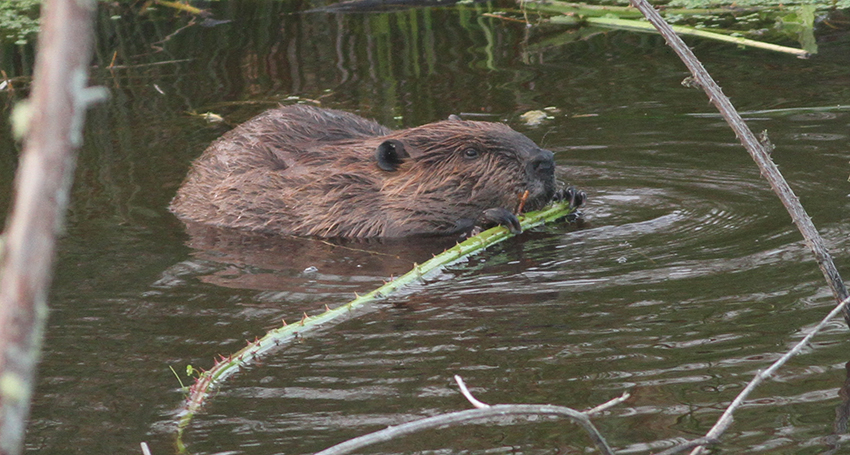
I looked out on an area that had been more or less a flat field of Pacific silverweed with some other terrestrial plants and grasses mixed in. In the past it had been easy walking, even in sneakers. Now it was almost entirely water, filled with a blanket of feathery Baltic rush. And the water was deep. It turns out that if a marsh stays underwater all the time, the plants decay and the marsh gradually turns into deep, gooey mire. At first there’s the water, but the solid ground—it’s down there somewhere. Bipedal creatures that wear boots and pants require solid ground. It took me three tries before I finally found a route out to my photo-point crabapple.
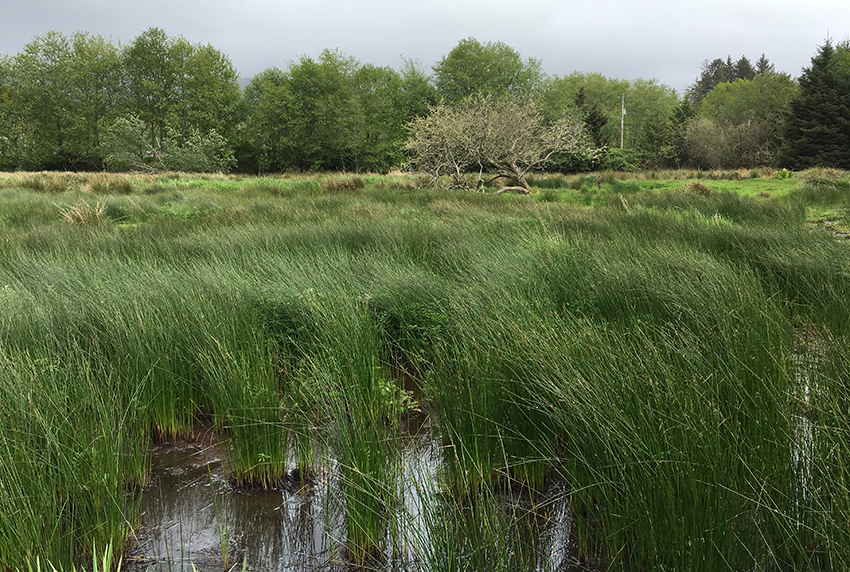
This old tree that I’d nicknamed Methuselah had become kind of a celebrity around here, being one of the main characters in my People+Plants+Wildlife essay in the fall. Neal Maine had taken a photo of the tree, and the photo had appeared at the top of the blog post, and then in a fundraising letter from NCLC, and finally in the conservancy’s annual report. It may not be NCLC’s official signature tree, but it certainly was this year. The real reason I’d come out here was to check on this tree.
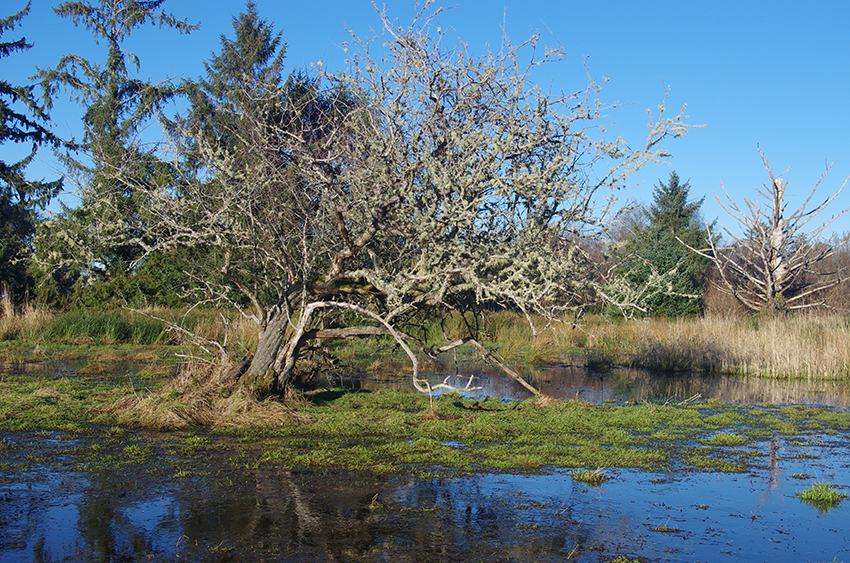
So now I was finally here, and what I saw was kind of what I’d expected. The tree had been sitting on a little raised part of the marsh that was just above the highest water level. Except now it was surrounded by water all the time, not just during the winter king tides. Only about half of the tree had leaves now, and that half didn’t look so good. I stared at the tree, looking closely at the branches, poking around. In my imagination I heard The Princess Bride’s Miracle Max say, “Look who know so much. It just so happens that your friend here is only mostly dead.” I thought, He’s right. This tree’s been through this before. It’s still slightly alive. Things could be worse.
When you think about it, whether or not these are the last leaves this tree ever gets to sprout, it’ll still be part of the marsh for many years to come. It’ll go from providing cover and a meal for cedar waxwings and deer to being a resting perch for an osprey and a home for mushrooms, beetles, and ants. A good rule of thumb is that a tree takes about as much time to decompose as it took for it to grow. In most cases there’s a lot more life—that is, living tissue—in a tree we call dead than there ever was when it was alive and producing cambium, leaves, and fruit.
I left the marsh that day in May feeling pretty hopeful about things. I’d resigned myself to accepting whatever was in store for this tree that I’d grown so used to seeing in this beautiful setting. I also realized that the marsh I’d come to know over these past six years had gone through a profound change that I had the privilege of watching and documenting.
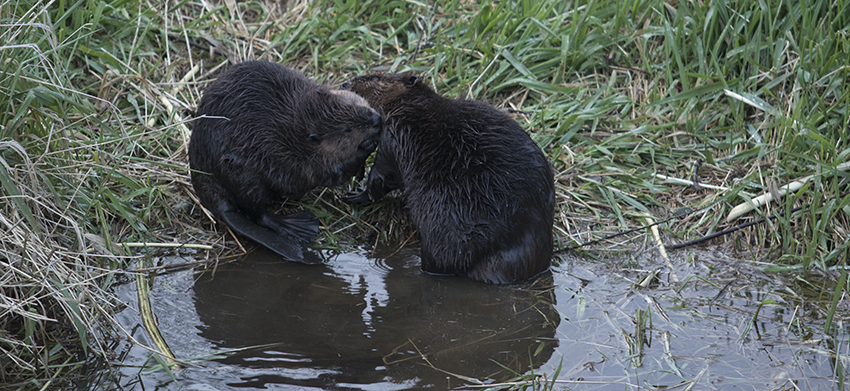
Now we’re back to the present. It’s late June and I’m on the wrong side of Coho Creek. I’m wondering what I’ll find today. Getting from here to there is a real challenge. The creek runs through a channel that’s about four feet below the marsh surface where I’m standing. You can backtrack through these bushes until you can finally ford the creek, scramble up to the highway, and then walk up to the other end of all this and re-enter the marsh. Or you can find a likely spot and jump, which I did.
Once I was on the other side of the creek, things were surprisingly the same as I might have seen last year. I was standing on a lush carpet of silverweed mixed in with a few sedges and grasses—easy going. I knew things would be a little drier because I’d peeked into the north end on China Creek before coming out here and noticed that the water was down a few more inches in the beaver pond.
But now as I looked north toward Wahanna Marsh I could see big changes! Up ahead was my old pal Methuselah. All around it now was a new marsh, complete with the Baltic rushes I’d seen in May, but now also with very large soft rushes, giving the site a completely new character. This land where I was standing had spent most of the last century as a farm in what was known as Bear Valley. Then since 1991, when it became NCLC’s first conserved property, it has been gradually turning itself back into a wetland, with NCLC’s encouragement. Now over a single winter it had arrived. It’s now a full-fledged, high tidal saltmarsh. Apparently all it needed was beavers!
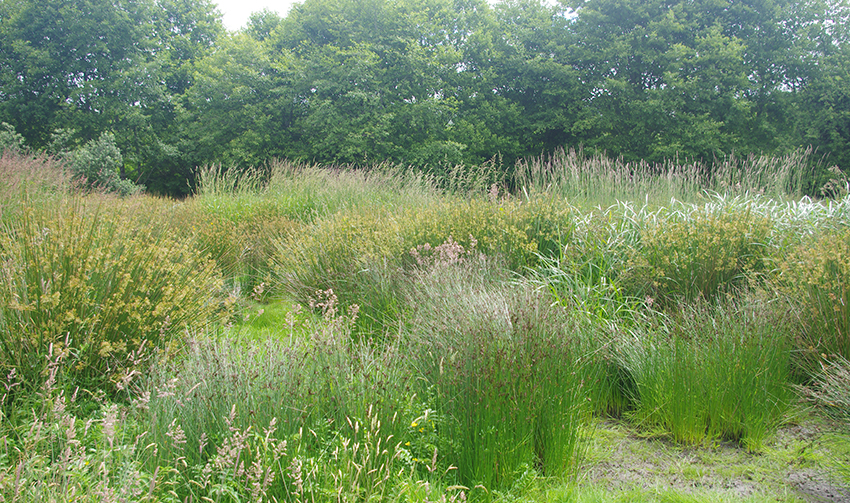
When I finally got close to my crabapple, I could see that it had changed along with its surroundings. Now about half of the tree had leafed out completely, but the rest of it was done. The lichens that give this tree its wonderful personality were still there, but now they were on some completely leafless branches. I say leafless, but not lifeless. The part of the tree that still has leaves looks pretty darn good. Summer will tell if we get flowers and fruit. We’ll see what the future brings.
I looked around at this new marsh. It’s muddy here, sloppy and wet. You can’t even walk over to the pond anymore. On the east bank there are several willows and alders that have been cut down by our new neighbors. I think that’s why some people dislike beavers. They mess things up, bring in water and mud, leave stumps and dead branches everywhere. To me it’s just a marvel of engineering that we could never hope to duplicate. This is the way of nature.
Now I finished my regular route through the small spruce grove and into the wetness that is now the home of our beavers. As I waded along the bank above China Creek, I looked over to check that big crabapple that’s in the center of those rose brambles. It’s the one that had all that ivy two years ago. There it was rising above the red elderberry and twinberry, looking healthy and happy. This is quite a slog, surveying both of these sites along with the open land in between. I always leave muddy, sweaty, and happy. It’s a real joy to still be out here.
Postscript: On Aug. 24 I walked back out on the marsh, and I’m happy to report that the part of Methuselah that still has leaves is full of crabapples.
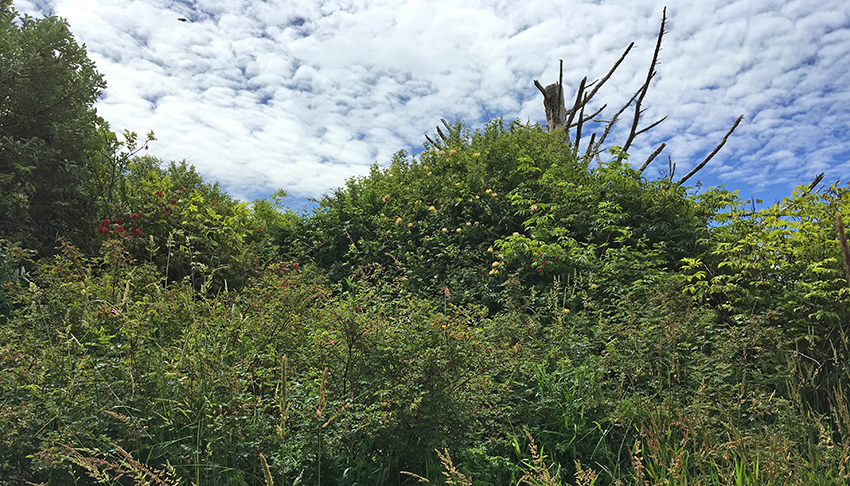
Thanks to Neal Maine of PacificLight Images for the photos of beavers in Wahanna Marsh.

Comments